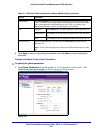
Virtual Private Networking Using IPSec, PPTP, or L2TP Connections
330
ProSecure Unified Threat Management (UTM) Appliance
3. In the IKE SA Parameters section of the screen, locate the DPD fields, and complete the
fields as explained the following table:
4. Click Apply to save your settings.
Configure NetBIOS Bridging with IPSec VPN
Windows networks use the Network Basic Input/Output System (NetBIOS) for several basic
network services such as naming and neighborhood device discovery. Because VPN routers
do not usually pass NetBIOS traffic, these network services do not function for hosts on
opposite ends of a VPN connection. To solve this problem, you can configure the UTM to
bridge NetBIOS traffic over the VPN tunnel.
To enable NetBIOS bridging on a configured VPN tunnel:
1. Select VPN > IPSec VPN > VPN Policies. The VPN Policies screen displays (see
Figure 181 on page 301).
2. In the List of VPN Policies table, click the Edit table button to the right of the VPN policy that
you want to edit. The Edit VPN Policy screen displays. (The following figure shows only the
top part of a UTM50 screen with the General section).
Table 83. Dead Peer Detection settings
Setting Description
IKE SA Parameters
Enable Dead Peer
Detection
Select the Yes radio button to enable DPD. When the UTM detects an IKE
connection failure, it deletes the IPSec and IKE SA and forces a reestablishment
of the connection. You need to specify the detection period in the Detection
Period field and the maximum number of times that the UTM attempts to
reconnect in the Reconnect after failure count field.
Detection Period The period in seconds between consecutive
DPD R-U-THERE messages, which are sent only when the
IPSec traffic is idle. The default setting is 10 seconds.
Reconnect after
failure count
The maximum number of DPD failures before the UTM tears
down the connection and then attempts to reconnect to the
peer. The default setting is 3 failures.


















